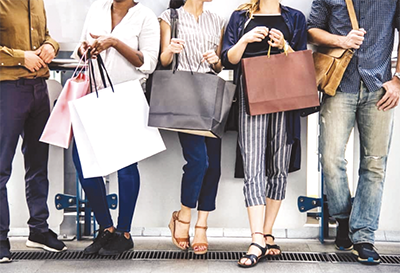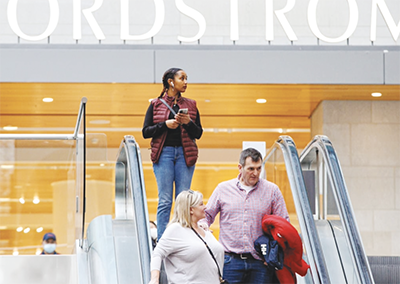Returning to Brick-and-mortar Stores
Shopping Becomes Social Activity Post-Pandemic
Since the Covid-19 pandemic, the unprecedented situation prolonged, and online retail stores thrived in the climate. Consumers who were afraid of infection went on to shop on smartphones and computers instead of going out for a shopping, and the retail industry responded by shutting down locations while increasing online staff to meet the soaring demand for online shopping. As the situation prolongs, some experts forecasted that the retail industry would survive exclusively through online sales.
However, along with the vaccination, the situation is improving, and the consumers are spending more time personally visiting and shopping in the stores instead of staying online. According to the Mastercard’s report released in June, the online purchase in May increased by 2.2% compared to the same month last year while the in-store purchase increased more sharply by 13.4%.
Although online shopping provides a quick and convenient way to shop, many consumers who have been forced to stay home for a long time have grown tired of this cut-down version of shopping and are not satisfied fully according to a research. Making a trip to a store with friends and families and feeling and touching various merchandise before making a purchase is an important experience for consumers bringing nostalgia and joy. These consumers are recognizing in-store shopping as a social activity.

Shoppers in a retail store ©bibohair
Especially, appliances and furniture purchased online will incur extra delivery cost, and potential repeat of the ordeal for refund or exchange. Also, you often experience the gap between the actual product you received and the product you expected. You can easily find many reviews complaining that “not what I expected” on product listings online.
As a result, many companies that made grandiose investments to the online front are withdrawing them. Amazon has expanded its warehouse and hired a lot of workers to meet the drastically increased demand during the pandemic. Now Amazon is subleasing some of their warehouse spaces. Online clothing and styling service Stitch Fix decided to lay off 330 employees as the slowing of e-Commerce market growth became evident. Carvana, an online used car sales platform, will lay off 2,500 employees or 12% of the entire workforce. A few startups that aimed to expedite delivery of fresh groceries to home are facing the reality of bankruptcy. According to S&P Global, the e-Commerce stocks are down by nearly 28% in 2022.
Editor and Research Analyst Berna Barshay of Empire Financial Research said that companies who were digital-based or on expanding of online services have recruited and made investment based on a bright outlook, but they are now facing a likelihood of not meeting growth targets and making effort to cut down expenses and size.
The prediction of permanent shift of retail business into online has been totally upended. Online purchase increased drastically as the Covid-19 changed our lives two years ago. Although by varying degrees, stores have shut down doors, and consumers of all ages started purchasing groceries, office supplies, furniture, sporting goods, and other essential goods online, contributing to a record e-Commerce sales. The e-Commerce sales peaked in 2020 Spring, and it is gradually declining as the Covid-19 related restrictions are lifted.
Companies invested in online advertisements and promotional mailing systems to grab consumer’s attention, and they expanded warehouse and fulfillment facilities for quicker delivery. They also partnered with delivery platforms like Instacart, DoorDash, and Uber Eats. However, the long awaited consumers are turning to the brick-and-mortar stores. Macy’s CEO Jeffrey Gennette said that in-store sales are unexpectedly high and digital sales revenue are proportionally decreasing, and the shopping patterns of consumers have drastically shifted from the pandemic period. Nordstrom also announced that more shoppers are shopping in-store while the online sales have stayed the same.
As parties and social events are increasingly thrown and many people are returning to the workplace ending remote work, in-store shopping picked up. For the past years that many people stayed home for a significantamount of time, casual outfits trended online. However, many people now want formal attires like dresses and suits, so they are making visits to the store for try-ons as those outfits typically require more effort for a good fit.
Loosened restrictions are also playing a role in boosting offline sales. In most states, facial masks are not mandated but left to personal choice, and thick screens that protect cashiers are disappearing. Shoppers can more freely talk to the employees, and the once-disappeared small talk has made a comeback. These have made the in-store shopping experience more satisfying than online shopping.
Barren’s June survey of 2,210 adults in the U.S. found that 73% of adult Americans feel comfortable to go to shopping malls for a purchase of goods. This is a 17 point increase from the same survey performed in the beginning of the year. According to the U.S. Census Bureau, despite the large profits generated through e-Commerce for the past years, the first quarterly report showed the online sales amounting only 14.3% of the total retail sales.
To welcome customers who are returning to the store, it is recommended to maximize their shopping experience. A more welcoming store atmosphere, good communication between staff and customers, and the advantage over online shopping, e.g. providing try-ons, can’t be emphasized enough.

Shoppers at a mall ©cbc.ca
The same goes for beauty supplies. The store atmosphere should return back to before the social distancing. Staff members should approach customers proactively and recommend or help looking for desired items, decorating the retail floor to a bright and vibrant scene, and so on should be implemented to increase the value of retail shopping experience.
During the pandemic, beauty supplies have seen the profit increase due to the self-beauty booms caused by the closure of salons and nail shops. It was a notable contrast to the overall downturn of the retail industry. As many customers are free to make appointments for beauty services, you need to understand the consumption pattern and consumer demand to keep rolling.
Of course, you should not underestimate the growth potential of e-Commerce just because the offline sales are back on track. The online ecosystem is still in progress, and some experts say it is a temporary setback for e-Commerce. In fact, many experts agree that sales via online channels will play a significant role in the growth of the retail industry overtime. It has been a long-circulated idea to mix online and offline to some extent. The beauty supply industry should also respond to the change in consumer behavior due to social dynamics.